What does it mean to call a design sustainable? According to the AIA website, the definition of sustainable design is as follows:
“Sustainable design is a collaborative process that involves
thinking ecologically—studying systems, relationships,
and interactions—in order to design in ways that
removes rather than contribute stress from systems.”
Source: AIA.ORG
It is the last phrase of the definition that this article will focus on, which states that sustainable design removes stress from systems. There are many designs and systems in a building where stress can be removed through sustainable solutions. The sustainable exterior shade removes stress on systems through energy reduction, glare reduction, and light control. In addition, exterior solar shades can contribute to popular green building movements such as LEED, WELL Building Standard and Passive House.
Energy Reduction
Exterior solar shades are critical elements in reducing the amount of solar energy entering a space and thereby reducing the need for cooling. This can have a significant effect especially when the shades are mounted on the exterior. Exterior solar shades provide tremendous reductions over interior shades for reducing solar heat gain. As the graphic below shows, an exterior shade can reduce the amount of solar radiation entering a space by over 85%.
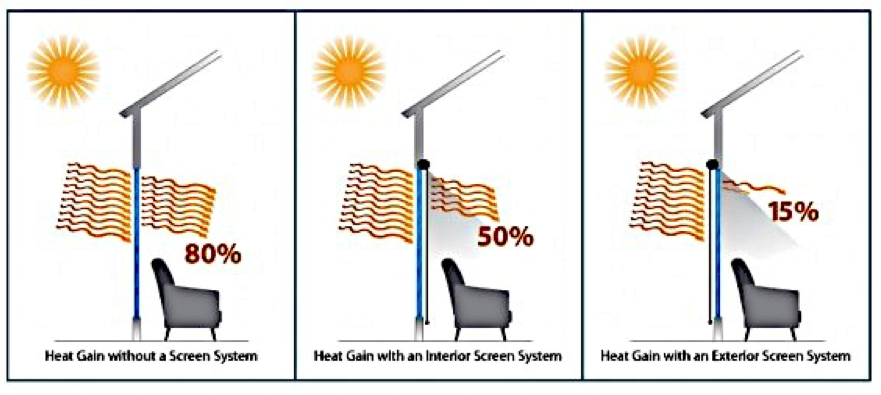
Glare Reduction
Too much daylighting in a space has the stressful consequence of providing annoying glare. Glare can cause great discomfort in all indoor conditions. Glare is caused by a significant ratio of luminance between the visual task and the glare source. An exterior solar shade will reduce the disparity in light levels as in between a computer screen and a window.
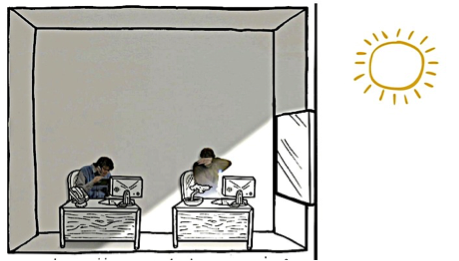
While using any color shade on the window will reduce glare, it is significantly more an effective remedy using a darker color over a lighter color. For example a white fabric can reduce glare by about 80%, while a black fabric reduces glare by 97%.
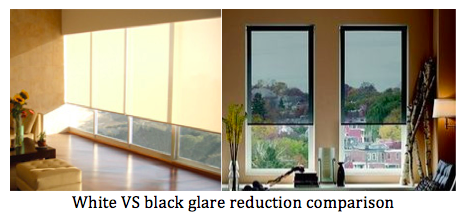
Light Control
To control the amount of light entering through a window, we have solutions that vary from light filtering fabrics to blackout conditions. For people with trouble sleeping with even the smallest amount of light, blackout-shading solutions can reduce this stress effectively. The Zip Blackout shade provides complete light blockage. The blackout fabric has a zipper-like device welded to its edges, which inserts into a sidetrack. This allows no light to seep through.
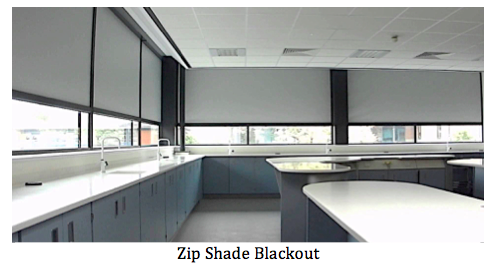
LEED, WELL & PASSIVE HOUSE
As you can see, exterior solar shades are just as an important building system as lighting and HVAC systems are. Not only do they play a huge role in reducing stress by through energy and glare reduction, they also play a part in today’s biggest sustainable building movements: LEED, WELL Building Standard and Passive House.
LEED
Bioclimatic architecture is to design in a way by using solar energy and local climate to provide thermal and visual comfort of the occupants. This is achieved by interacting with outside elements to best utilize natural light and air while providing thermal and visual comfort. These are the basis for earning points for LEED certification with exterior solar shades.
Exterior solar shades have a high impact on the available LEED points attributed to daylighting (Indoor Environmental Quality Credit) of a certain percentage of the building. There are many other points available related to automated window coverings but they would need to work in conjunction with the lighting and HVAC system within the building.
Some potential points include light pollution reduction (Sustainable Sites Credit) thermal comfort of occupants and providing quality views (Indoor Environmental Quality Credit).
Exterior solar shades has the ability to contribute to the optimization of the energy performance within the entire building by influencing how the building envelope interacts with the environment – due to points being delivered against energy saving percentage all systems within the building must work in unison to achieve the available 18 points. (Energy & Atmosphere Credit).
The overall LEED objective is to achieve a truly holistic approach in building design to ensure all systems will work together to reduce the energy footprint and increase occupant comfort. Automated exterior solar shades have the ability to provide LEED points necessary to help projects achieve certified, silver, gold, or platinum status.
WELL Building Standard
Green building trends and organizations has made significant achievements in setting standards for more sustainable solutions by utilizing exterior solar shades. Most of these gains have focused on energy and water conservation, recycled materials and environmentally conscious building practices. During this time little has been done to create strategies to improve the health and well being of how the occupants of these building fare. Things are changing with rapid pace on a significant scale.
The WELL Building Standard is leading this charge into improving the health and wellness of building occupants. WELL is the world’s first building standard focused exclusively on human health and wellness. It marries best practices in design and construction with evidence-based medical and scientific research – harnessing the built environment as a vehicle to support human health and wellbeing.
The WELL Building Standard sets performance requirements in seven categories relevant to occupant health in the built environment – Air, Water, Nourishment, Light, Fitness, Comfort and Mind.
Exterior solar shades play a significant part for a building to achieve silver, gold or platinum WELL certification. The WELL Building Standard includes two areas under the Light concept where shading solutions play a role: Solar Glare Control and Automated Shading.
Solar Glare Control
Glare is caused by a significant ratio of luminance between the visual task and the glare source. A solar shade will reduce the disparity in light levels as in between a computer screen and a window. (Refer to the previous description of glare control in this article.)
Automated Shading
Automated shading control for the WELL Building Standard suggests shading control systems that will adjust the level of the shades to protect the occupants’ from excessive glare without disrupting occupants from other tasks. The Somfy Animeo system will adjust and maintain the solar shade height to limit the distance that sunlight enters the space. This results in the ability to protect furnishings, maximize daylight availability and minimize glare on work surfaces and computer screens.
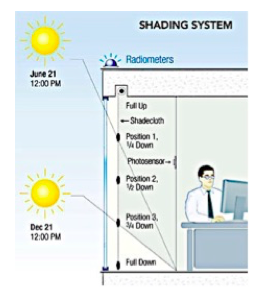
The Somfy Animeo can also be programed for real and astronomic timed events. With Animeo Timed Events feature, schedules can be created to keep buildings energy efficient based on certain times of day. Creating timed events around periods of high occupancy (between 8:00AM and 6:00PM, Monday through Friday) and low occupancy (weekends, holidays) ensures the building is running as efficiently as possible.
Passive House
After years of popularity throughout Europe, The Passive House is finally hitting the shores of the USA. We are seeing new projects being designed and built by architects and contractors trained specifically for this exciting technology. In fact, the tallest Passive House in the world is being built in New York City on Roosevelt Island for the new Cornell Tech housing facility.
A primary goal of a Passive House is to reduce the energy costs of the building by 90%. Designers of the Passive House are using a variety of tools in their toolbox to achieve this goal. One of these tools includes exterior solar shades.
One of the biggest challenges for a Passive House design is the glazing and solar heat gain passing through. While this works well in the winter months where you want that low sun to radiate heat into the space, the solar radiation needs to be blocked on east and west windows during summer months with exterior solar shades.
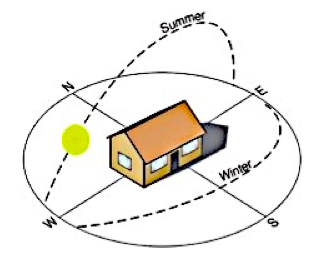
Of course the high summer sun also is effectively controlled by exterior shading blocking up to 90% of all solar heat gain when used with the properly selected shade fabrics. Using mesh fabrics allows the preservation of the exterior views and can allow outside ventilation air to easily pass through to interior spaces.
{{cta(‘ab5bb3dd-773c-4050-8381-b32aefdf2821′,’justifycenter’)}}
Conclusion
Exterior solar shades play a large role in a myriad of ways in reducing stress from building systems. Not only in cost savings, but also in providing a comfortable environment for people to live, learn, recover and work in. The sustainable exterior solar shade is not just something we hang on our windows to provide privacy; it is an integral part of today’s dynamic façade.
Think of the dynamic façade as a “third skin”. Our skin is the first skin; clothing the second skin and the envelopes of our buildings the third skin. As a skin, it needs to protect and breathe. The facades of our buildings be it a Passive House with its air exchange system or a Double-skin Façade with its ventilated chambers, are amazing Bioclimatic solutions and exterior solar shades are integral part of the success of these building innovations.
